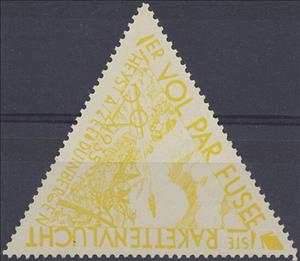Stamp: The launched Rocket (Belgium 1935)
The launched Rocket (Belgium 1935)
09 May (Belgium ) within release Rocket mail goes into circulation Stamp The launched Rocket face value None No Face Value
| Stamp The launched Rocket in catalogues | |
|---|---|
| Belgium: | Bel: BE E9 |
Stamp is square format.
The engineer Roberti, in collaboration with the postal administration, has launched the first rocket for postal transport in Duinbergen, Heist aan ZeeAlso in the issue Rocket mail:
- Stamp - Launching of the Rocket face value None;
- Souvenir Sheet - Launching of the Rocket - Souvenir Sheet face value None;
- Stamp - The launched Rocket face value None;
- Souvenir Sheet - The launched Rocket - Souvenir Sheet face value None;
- Stamp - View of the launch site on the Beach Of Duinbergen face value None;
- Stamp - Launching of the Rocket face value None;
- Stamp - The launched Rocket face value None;
- Stamp - View of the launch site on the Beach Of Duinbergen face value None;
- Souvenir Sheet - Launching of the Rocket - Souvenir Sheet face value None;
- Souvenir Sheet - View of the launch site, Beach Of Duinbergen - Souv. Sheet face value None;
- Souvenir Sheet - View of the launch site, Beach Of Duinbergen - Souv. Sheet face value None;
|
Data entry completed
50%
|
|
|---|---|
| Stamp The launched Rocket in digits | |
| Country: | Belgium |
| Date: | 1935-05-09 |
| Emission: | Erinnophilia |
| Format: | Stamp |
| Face Value: | None No Face Value |
Stamp The launched Rocket it reflects the thematic directions:
A rocket (from Italian: rocchetto, lit. 'bobbin/spool') is a vehicle that uses jet propulsion to accelerate without using any surrounding air. A rocket engine produces thrust by reaction to exhaust expelled at high speed. Rocket engines work entirely from propellant carried within the vehicle; therefore a rocket can fly in the vacuum of space. Rockets work more efficiently in a vacuum and incur a loss of thrust due to the opposing pressure of the atmosphere.
In the visual arts, a cityscape (urban landscape) is an artistic representation, such as a painting, drawing, print or photograph, of the physical aspects of a city or urban area. It is the urban equivalent of a landscape. Townscape is roughly synonymous with cityscape, though it implies the same difference in urban size and density (and even modernity) implicit in the difference between the words city and town. In urban design the terms refer to the configuration of built forms and interstitial space.
The Kionga Triangle (German: Kionga-Dreieck, Portuguese: Triângulo de Quionga) was a small region of German East Africa situated at the mouth of the Ruvuma River. The Ruvuma served as the border between the German colony and Portuguese Mozambique, and the Kionga Triangle was the only section of German East Africa south of the river. Its principal settlement was Kionga (now Quionga ) which had a population of 4,000 in 1910. It became a German possession in 1894 but came under Portuguese control in April 1916 during World War I. The post-war Treaty of Versailles reaffirmed that the river was the border between Tanganyika, then under British control, and Portuguese Mozambique. The triangle was the only territory that the treaty awarded to Portugal.

